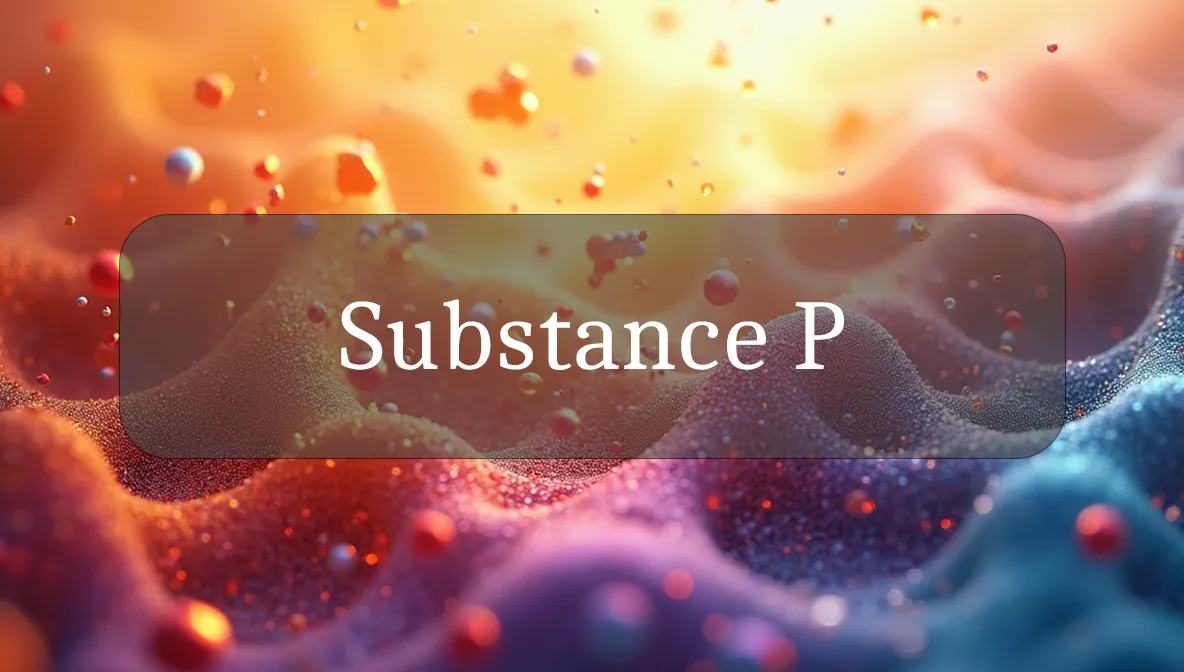Pain and Protection Signal for Body Awareness
Substance P is like your body’s alarm system, a neuropeptide that signals pain, inflammation, and stress to keep you aware of potential harm. Found in your nervous system, it plays a key role in protecting you while also influencing mood and immunity, making it a fascinating focus for health-conscious folks. Understanding Substance P can empower you to make choices that manage pain and support wellness. Let’s explore what Substance P is, why it matters, and how you can balance its effects for daily vitality!
Chemical Identity and Type
Substance P is a neuropeptide, a body signal made of 11 amino acids, belonging to the tachykinin family. It’s produced in sensory neurons, the spinal cord, and brain, acting as a neurotransmitter and neuromodulator. Substance P binds to neurokinin-1 (NK1) receptors to transmit pain signals and trigger inflammation. Think of it as a vigilant lookout, alerting your body to injury or stress while rallying defenses.
Biological Role and Benefits
Substance P is a key player in your body’s sensory and protective systems, offering these benefits:
- Pain Signaling: It transmits pain messages to the brain, helping you respond to injuries or avoid harm.
- Inflammation Response: Substance P triggers inflammation to fight infections or heal tissues, supporting recovery.
- Immune Support: It activates immune cells, enhancing your body’s defense against pathogens.
- Gut Function: It regulates gut motility and secretion, aiding digestion and nutrient absorption.
- Stress Response: Substance P helps coordinate responses to stress, ensuring alertness and resilience.
Balanced Substance P levels keep you protected, responsive, and healthy, while excess can amplify discomfort.
Dietary or Natural Sources
Your body makes Substance P naturally, so you don’t get it from food. However, you can support its regulation with these nutrient-rich choices:
- Anti-Inflammatory Foods: Fatty fish, turmeric, and berries (rich in omega-3s and antioxidants) reduce excessive Substance P-driven inflammation.
- Protein-Rich Foods: Eggs, chicken, fish, and beans provide amino acids for neuropeptide synthesis.
- Magnesium-Rich Foods: Spinach, almonds, and dark chocolate support nerve health and pain modulation.
- Vitamin B-Rich Foods: Whole grains, eggs, and leafy greens supply B6, which aids neurotransmitter balance.
A balanced diet helps manage Substance P’s inflammatory effects and supports nervous system health.
Signs of Imbalance or Dysfunction
Substance P imbalances—typically too high—can show up as:
- Chronic Pain: Persistent pain, such as in arthritis, fibromyalgia, or migraines, due to amplified pain signaling.
- Inflammation Overload: Redness, swelling, or heat in tissues, linked to conditions like psoriasis or asthma.
- Digestive Issues: Abdominal pain, bloating, or diarrhea, as seen in irritable bowel syndrome (IBS).
- Mood Disturbances: Anxiety or irritability, as Substance P can influence brain stress pathways.
- Skin Sensitivity: Itching or rashes, often tied to inflammatory skin conditions.
These symptoms can have many causes, so if they persist, consult a healthcare provider to explore pain or inflammation-related issues.
Supporting Optimal Levels or Function
To balance Substance P’s effects, try these evidence-based tips:
- Eat Anti-Inflammatory Foods: Include salmon, blueberries, or ginger to reduce excess inflammation driven by Substance P.
- Exercise Moderately: Activities like yoga, swimming, or walking can lower pain sensitivity and modulate Substance P release.
- Manage Stress: Meditation, deep breathing, or mindfulness reduce stress hormones that amplify Substance P activity.
- Prioritize Sleep: Aim for 7–9 hours of quality sleep to support nerve repair and pain regulation.
- Avoid Irritants: Limit spicy foods, alcohol, or smoking if they trigger pain or inflammation in sensitive individuals.
Small, consistent habits create a pain-friendly environment for managing Substance P’s effects.
Safety, Interactions, and Precautions
Substance P is a natural neuropeptide and safe when balanced, but consider these factors:
- Chronic Pain Conditions: Disorders like fibromyalgia, migraines, or IBS may involve elevated Substance P and require medical management.
- Medications: Drugs like capsaicin creams or NK1 receptor antagonists (e.g., aprepitant) target Substance P pathways but may cause side effects like burning or nausea. Discuss with your doctor.
- Supplements: Omega-3s, curcumin, or quercetin may reduce Substance P-related inflammation but can interact with medications. Consult a healthcare provider before use.
- Allergies or Sensitivities: Some foods or environmental triggers (e.g., pollen) may increase Substance P activity in sensitive individuals, worsening symptoms.
Balancing Substance P means supporting nerve health and minimizing inflammatory triggers.
Fun Fact
Did you know Substance P is why spicy foods make your mouth burn? Capsaicin in chili peppers triggers its release in sensory nerves, sending a fiery pain signal that some people crave!
Citations
- National Institutes of Health (NIH): Substance P and Pain Signaling.
- Mayo Clinic: Chronic Pain and Inflammation.
- Cleveland Clinic: Nutrition and Nervous System Health.
- World Health Organization (WHO): Diet and Anti-Inflammatory Guidelines.
- USDA: Dietary Guidelines for Americans – Nutrient-Dense Diets.

